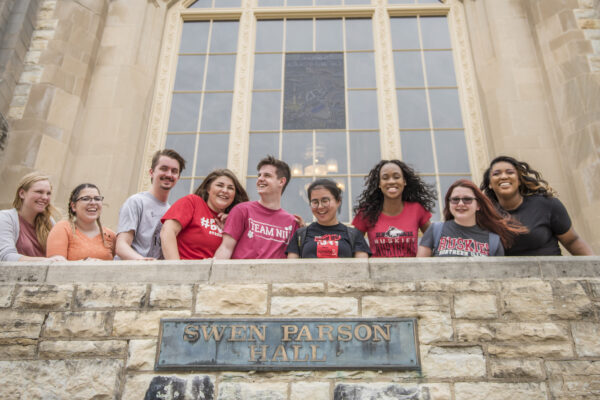By Haelim Chun and Jung Hyun Choi
For decades, the United States has been the number one destination for international students pursuing higher education. A high-quality education, a diverse environment, advanced technology, flexible support systems, and opportunities to work and develop their skills after graduation have been important reasons why international students choose U.S. colleges and universities year after year.
However, things have changed in recent years, both in terms of U.S. policy and the general climate facing international students who are considering coming to this country. After President Trump was inaugurated in 2017, one of his first acts was to issue a travel ban that placed stringent restrictions on travel to the United States for citizens of certain countries. Following protests and legal challenges, the administration was forced to withdraw the ban, and it had to make two more attemps before drafting a much narrower one that could actually be implemented.
Fast-forward to 2020 and the COVID-19 pandemic. International students and scholars, who have dealt with three years of uncertainty, now face new uncertainties in their visa status. On July 6, the U.S. immigration and Customs Enforcement’s Student and Exchange Visitor Program (SEVP) announced that non-immigrant students (F-1 and M-1 visa holders) taking only online classes in the fall semester must leave the country or transfer to an institution that offers in-person courses. However, as with the travel ban, the administration had to keep trying—after withdrawing the July 6 directive under pressure of a lawsuit from Harvard and MIT, it issued another one on July 15 and then a final one July 24. This latest, which bars new international students from entering the country to enroll in an institution that is all-online, seems to be what students and campuses will have to deal with this fall.
Policies and practices that make international students feel unwelcome are just part of the problem. Another is the myths such policies build around international students and scholars that reinforce a generally unwelcoming climate in this country. We are here to dispel four misconceptions about international students in the United States that must be corrected so that policies actually benefiting U.S. society can be designed and implemented.
Misconception #1: International students’ economic contribution to the United States is small
In 2019, the education service exports ranked sixth among service exports in United States. Over 1 million international students were enrolled in U.S. universities, creating 458,000 jobs, and contributing approximately $44.04 billion to the U.S economy. The contribution of international students has continuously increased since 2008. This is only counting their contribution in dollars, including tuition to institutions, but also food and clothing, transportation, health insurance, and other living expenses to the larger economy, and not the positive spillover effects gained from interacting with a diverse population that enhances knowledge and creativity.

Source: NAFSA (2019). Economic Value Statistics
There is often the misunderstanding that international students receive funds from their college. However, about 92 percent of undergraduate students bring personal funding outside the United States, including family sources and other scholarships from their home country governments or various foundations. For graduate students, 36.4 percent are funded by their universities (IIE 2019). However, the majority of graduate students are paid minimum wage to work as teaching or research assistants, and often face financial strains.
The average in-state tuition for domestic students in U.S. public four-year universities is $8,182 after institutional financial aid is applied. The average foreign students pay almost three times more than this amount ($22,048). While domestic students receive financial aid, international students bear the full amount of tuition, a significant contribution to their campus.
Statistics show that both undergraduate and graduate students bring tremendous economic value in the United States. In addition to their economic contribution, international students also bring their unique experiences and perspectives that promote diversity and creativity in the U.S. academic system and their host communities.
Misconception #2: Most international students stay in the United States after graduation
Optional Practical Training (OPT) allows undergraduate and graduate students with F-1 status to work for one year on a student visa, or for three years in science, technology, engineering, and mathematics (STEM) fields, toward getting practical training to complement their education. Since 2009, the number of international students who stayed after graduation and worked with OPT approval in the United States has increased consistently.

Source: IIE Open Doors (2019)
Yet international students need approval from the U.S. government to work after graduation, which is costly and cumbersome for the employers. OPT only allows international students to work for a short period of time, and in the Trump administration there have been more delays in processing OPT, sometimes up to five months. This delay affects the starting date and length of time the students can work under this visa, which makes some students give up and leave before their application is processed.
Since the outbreak of COVID-19, the Trump administration has made several abrupt announcements related to international student visas. On June 22, the president signed an executive order suspending the issuance of H1-B and other temporary work visas through the end of the year. He followed that with an executive order restricting federal agencies from contracting or subcontracting with workers on H1-B visas. The administration also was considering suspending OPT, but backed off after receiving strong opposition from academia and businesses.
The major arguments behind suspending OPT and other work authorization visas are to protect Americans from the disadvantages of competing with non-citizens during the economic crisis. However, there is little evidence that non-citizen workers, especially those with a college degree or higher, threaten U.S. workers. In a time of high uncertainty in the labor market, the only potential benefit from suspending OPT and other work authorizations is winning some votes of people who are worried about their job stability by shifting their attention to the wrong target. If banning work visas is truly due to economic reasons, then this not the direction that the U.S. government should be heading toward. These actions, in fact, will lead to substantial financial, political, and social damages.
Misconception #3: International students who remain will take away jobs from U.S. citizens
In contrast to the common public opinion, most economic research finds that immigrants do not harm Americans’ wages and job opportunities. This is because the economy responds to the influx of immigrants by increasing labor demand. The actual impact of immigrants is small, especially over the long-term.
To apply for working visas, international applicants need to have a college degree, and those who seek jobs in the United States are most likely to have a graduate degree. The negative economic shock since the outbreak of the pandemic has not been the same across education groups. The following figure shows that the unemployment rate increased for all education groups, but the increase was substantially smaller for those with master’s and doctoral degrees than those with lower educational attainment. This indicates that even in negative economic circumstances, the impact of international students on the labor market would not be large, especially when businesses are likely to be reluctant to go through the complicated documentation to hire the international job candidates amidst the pandemic.

Source: FRED Economic Data
Additionally, among 270 industries in the 2018 American Community Survey data, 28 percent of young foreign workers with a college degree work in three industries: (1) Computer systems design and related services; (2) Colleges, universities, and professional schools, including junior colleges; (3) General medical and surgical hospitals, and specialty hospitals (except psychiatric and substance abuse). These industries have experienced a relatively smaller decline in employment due to COVID-19. While the total non-farm employment in the United States dropped by 12.7 percent between February and May, the employment of the three industries declined by just 4.3 percent. Again, this suggests that international students are working and seeking jobs that are less impacted by COVID-19.
Misconception #4: The United States will always remain the no. 1 study abroad destination
Since 2017, the number of international students enrolled in U.S. colleges and universities has declined for three consecutive years. The new enrollment for international students in the United States fell by 3 percent between 2017 and 2019, while the number increased in the UK, Canada, and Australia. The number of newly enrolled international students in Canada rose by almost 30 percent, 13 percent in Australia, and 9 percent in the UK.

Source: IIE Open Doors (2019), Immigration, Refugees and Citizenship Canada (IRCC) (2019), Australian Trade and Investment Commission(2019), Studying in UK (2019)
In contrast to the United States, Canadian universities have implemented policies to attract more international students by offering competitive packages, allowing students to work while they study, exempting travel restrictions, and reducing barriers for students to obtain working visas. Moreover, international students pay less tuition than students, especially in Canada and Australia. The tuition fees at U.S. institutions are around $26,000 for international students, while the average cost of Canadian and Australian universities is approximately $20,000.
The relationship between international students and the United States has been mutually beneficial for decades. However, recent incidents have awakened international students to see the reality. Furthermore, the decline in international students is likely to continue due to COVID-19, the unstable visa policies of Trump administration, an unwelcoming environment, increasing racial discrimination, and xenophobic violence.
In times of pandemic, international students become one of the most vulnerable groups. They suffer from limited safety nets and become victims of political power games. These barriers will discourage international students from pursuing higher education in the United States and will encourage them to find an alternative place to study. After all, they have plenty of other options.
If you have any questions or comments about this blog post, please contact us.


